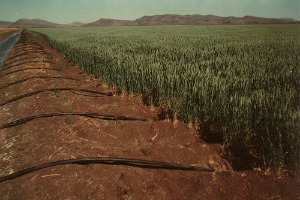WITHIN the context of impending climate variability and the uncertainty of unstable markets, soil experts are speaking up about the necessity to continue focusing on the State’s land management practices.
“Especially in the south-west of WA, we were dealt a really ‘difficult hand’ in terms of soil, in that many of the soils in that region are notoriously low in fertility,” Murdoch University soil fertility and land management specialist Professor Bell says.
“This arises from the fact that it is an old landscape that has been deeply weathered for millions of years—unlike much of Europe where glaciation stripped away all the old soils and they’ve got newly weathered soils that are no more than 10,000-years-old in some cases.”
According to Soils For Life, a non-for-profit organisation committed to sustainable environmental practice that undertakes studies in WA; Australia, “needs to redesign itself to ensure resilience of our agriculture system and the ecosystem on which it depends”.
They claim future challenges include; an increasingly arid landscape; increased erosion; longer drought and consequently more bushfires; more severe storms; population growth and therefore need for food production.
They also estimate WA’s salinity has been spreading at the rate of about a football ground per hour.
Unfortunately, Prof Bell says we do not have solutions for this major problem yet but are developing techniques in the right direction.
Techniques include a greater use of perennial plants in the landscape: planting oil mallee, tree forages like tagasaste, and saltbush.
“Farmers are adopting many of these, and we’ve actually been saved somewhat by droughts of the past decade that have halted salinity, but if we go back to a series of wet seasons we will see salinity back on the agenda,” Prof Bell says.
He also says soil acidity is an ongoing issue and Australian farming methods tend to cause soils to acidify over time.
“You can arrest that with adding lime, but farmers aren’t currently using anywhere near as much lime as they would need to hold the problem, generally because of cost,” he says.
“The benefit of lime only pays off after 3-5 years, rather than immediately.”
There are other techniques experts and organisations like Soils For Life are striving to achieve sustainable agricultural practice too, such as; encouraging natural biological cycles and nutrient transfer; time-controlled planned grazing; and investing in revegetation.
For some commentators though, such as Jared Diamond in his recent book Collapse, the future of Australian soils and agriculture still looks grim.
However, Prof Bell says many such reports tend to have a “historical” perspective.
“The evidence that’s the easiest to report and scrutinise tends to be at least 10 years out of date, compared to what’s happening now,” he says.
“Especially in the south-west of WA, we were dealt a really ‘difficult hand’ in terms of soil, in that many of the soils in that region are notoriously low in fertility,” Murdoch University soil fertility and land management specialist Professor Bell says.
“This arises from the fact that it is an old landscape that has been deeply weathered for millions of years—unlike much of Europe where glaciation stripped away all the old soils and they’ve got newly weathered soils that are no more than 10,000-years-old in some cases.”
According to Soils For Life, a non-for-profit organisation committed to sustainable environmental practice that undertakes studies in WA; Australia, “needs to redesign itself to ensure resilience of our agriculture system and the ecosystem on which it depends”.
They claim future challenges include; an increasingly arid landscape; increased erosion; longer drought and consequently more bushfires; more severe storms; population growth and therefore need for food production.
They also estimate WA’s salinity has been spreading at the rate of about a football ground per hour.
Unfortunately, Prof Bell says we do not have solutions for this major problem yet but are developing techniques in the right direction.
Techniques include a greater use of perennial plants in the landscape: planting oil mallee, tree forages like tagasaste, and saltbush.
“Farmers are adopting many of these, and we’ve actually been saved somewhat by droughts of the past decade that have halted salinity, but if we go back to a series of wet seasons we will see salinity back on the agenda,” Prof Bell says.
He also says soil acidity is an ongoing issue and Australian farming methods tend to cause soils to acidify over time.
“You can arrest that with adding lime, but farmers aren’t currently using anywhere near as much lime as they would need to hold the problem, generally because of cost,” he says.
“The benefit of lime only pays off after 3-5 years, rather than immediately.”
There are other techniques experts and organisations like Soils For Life are striving to achieve sustainable agricultural practice too, such as; encouraging natural biological cycles and nutrient transfer; time-controlled planned grazing; and investing in revegetation.
For some commentators though, such as Jared Diamond in his recent book Collapse, the future of Australian soils and agriculture still looks grim.
However, Prof Bell says many such reports tend to have a “historical” perspective.
“The evidence that’s the easiest to report and scrutinise tends to be at least 10 years out of date, compared to what’s happening now,” he says.
Original Article Here


No comments:
Post a Comment